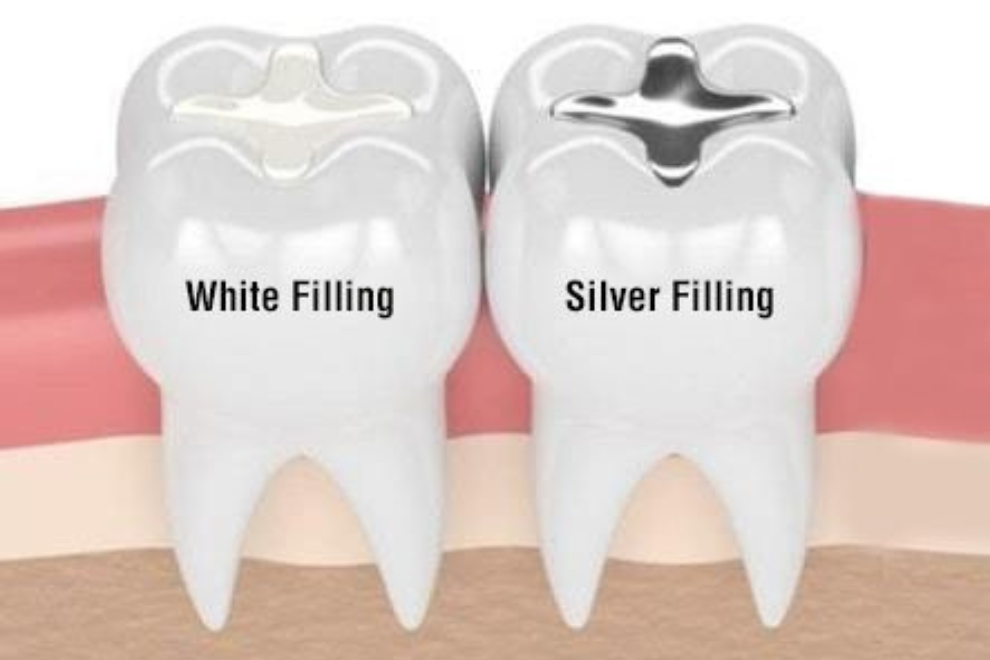What Are White Fillings and Silver Fillings?
White Fillings
White fillings, also known as composite fillings, are made from a resin-based material that is designed to blend seamlessly with the natural color of the teeth. These dental fillings are often used in visible areas of the mouth because of their aesthetic appeal. Composites bond directly to the tooth structure, which can strengthen the tooth and prevent further decay.
Silver Fillings
Silver fillings, or amalgam fillings, have been used in dentistry for over a century. They are composed of a mixture of metals, including mercury, silver, tin, and copper. Known for their durability, silver fillings are often used for molars or teeth that endure heavy chewing. However, their metallic appearance makes them less desirable for visible teeth.
Key Differences between White and Silver Fillings
- Aesthetic Appeal
- White Fillings: Blend with the natural tooth color, making them almost invisible. Ideal for front teeth and other visible areas.
- Silver Fillings: Highly noticeable due to their metallic sheen, making them less suitable for visible teeth.
- Durability
- White Fillings: While durable, they are slightly less robust than silver fillings, especially under heavy chewing pressure.
- Silver Fillings: Extremely durable and can last longer in molars or areas with heavy chewing.
- Tooth Preservation
- White Fillings: Require less removal of healthy tooth structure, preserving more of the natural tooth.
- Silver Fillings: Often require more extensive drilling, which can weaken the tooth over time.
- Cost
- White Fillings: Generally more expensive due to the material and the additional time required for placement.
- Silver Fillings: More affordable and quicker to place, making them a budget-friendly option.
- Longevity
- White Fillings: Typically last around 5-7 years but may require replacement sooner in high-stress areas.
- Silver Fillings: Can last 10-15 years or more with proper care.
- Safety and Concerns
- White Fillings: Free from mercury and considered safe.
- Silver Fillings: Contain mercury, which has raised some health concerns, though studies suggest the levels are generally safe.
Pros and Cons of White Fillings
Pros of White Fillings
- Natural Tooth Color (Aesthetic Appeal)
White fillings are designed to match the color of your child’s natural teeth. This makes them virtually invisible, which is ideal for visible teeth such as incisors or canines. Children and teens often prefer white fillings to avoid the noticeable metallic appearance of silver fillings. - Bonding to the Tooth Structure
White fillings bond directly to the tooth, creating a strong, supportive seal. This bonding process helps to strengthen the tooth, reduce the risk of future breakage, and prevent further decay by sealing out bacteria. It also allows dentists to preserve more of the natural tooth compared to silver fillings. - Preservation of Tooth Structure
Since composite fillings bond directly to the tooth, they require less drilling and removal of healthy tooth structure. This minimally invasive approach helps maintain the integrity of your child’s natural tooth. - Mercury-Free
Unlike silver amalgam fillings, white fillings do not contain mercury, making them an appealing choice for parents who are concerned about potential health risks associated with mercury exposure.
Cons of White Fillings
- More Expensive
White fillings typically cost more than silver fillings. The higher cost is due to the material used and the additional time required for placement. Insurance coverage for composite fillings may also be more limited, which could mean higher out-of-pocket expenses. - May Not Be as Durable for Larger Cavities
While white fillings are durable, they may not withstand the same amount of pressure as silver fillings, particularly for larger cavities in molars or back teeth. These fillings are more prone to wear and may need replacement sooner, especially if your child grinds their teeth or consumes a lot of hard or sticky foods. - More Time-Consuming
Placing white fillings requires careful layering and curing with a special light, which can make the procedure longer compared to silver fillings. This might be challenging for younger children who have difficulty sitting still for extended periods. - Susceptible to Staining
Over time, white fillings can become stained by foods, drinks, or poor oral hygiene. They may require more maintenance and possibly replacement if discoloration occurs.
Pros and Cons of Silver Fillings
Pros of Silver Fillings
- More Durable for Back Teeth
Silver fillings are exceptionally strong and can withstand the significant chewing forces exerted on molars and other back teeth. They are a reliable option for larger cavities or areas where durability is critical, making them a preferred choice for teeth that handle heavy chewing. - Cost-Effective Option
Silver fillings are typically more affordable than white (composite) fillings. The lower cost makes them a practical choice for families looking for a budget-friendly solution, especially when multiple cavities need to be treated. Many insurance plans fully cover amalgam fillings due to their long-standing use and reliability. - Long-Lasting
Silver fillings are known for their longevity, often lasting 10-15 years or longer with proper oral care. This durability can reduce the need for frequent replacements, providing a long-term solution for your child’s dental health. - Quick Placement
The procedure for placing silver fillings is generally quicker than for white fillings. This can be an advantage for younger children who have difficulty sitting still for extended periods during dental procedures.
Cons of Silver Fillings
- Noticeable Metallic Color
One of the most significant downsides of silver fillings is their appearance. The metallic color is easily noticeable, especially in visible areas of the mouth. This can make children or teens self-conscious about their smiles, particularly if the fillings are on their front teeth. - Contains a Small Amount of Mercury
Silver fillings are composed of a mixture of metals, including mercury. While dental associations, including the American Dental Association (ADA), deem the levels of mercury in amalgam fillings to be safe, some parents remain concerned about potential health risks. For children with sensitivities or those who prefer mercury-free options, this can be a drawback. - Requires More Tooth Removal
Silver fillings don’t bond to the tooth like white fillings do. Therefore, more healthy tooth structure needs to be removed to create a shape that holds the filling securely. Over time, this can potentially weaken the tooth. - Potential for Expansion and Contraction
Silver fillings can expand and contract with temperature changes from hot or cold foods. This movement can, in rare cases, lead to cracks or fractures in the tooth structure. - Allergic Reactions
Although rare, some children may have allergies or sensitivities to the metals in amalgam fillings. If your child has a known metal allergy, a different filling material might be preferable.
Factors to Consider When Choosing Fillings
1. Location of the Cavity (Front vs. Back Teeth)
- Front Teeth: For cavities in visible areas, such as the front teeth (incisors and canines), white fillings are typically the best choice. They match the natural color of the tooth, providing an aesthetic, seamless appearance.
- Back Teeth: For molars or premolars that endure heavy chewing, silver fillings are often more durable and long-lasting. The metallic appearance is less of a concern in these less-visible areas.
Recommendation: White fillings for front teeth, silver fillings for back teeth that require durability.
2. Size and Severity of the Cavity
- Small to Medium Cavities: White fillings are effective for small to medium-sized cavities because they bond well to the tooth and require minimal removal of healthy tooth structure.
- Large Cavities: For larger cavities, especially those in high-pressure chewing areas, silver fillings are often more reliable due to their superior strength and durability.
Recommendation:
- White fillings for small cavities in any location.
- Silver fillings for large cavities in back teeth where durability is essential.
3. Cost Considerations and Insurance Coverage
- White Fillings: These are typically more expensive due to the cost of materials and the time-consuming placement process. Some insurance plans cover white fillings only for front teeth or may require additional out-of-pocket payments.
- Silver Fillings: Generally more affordable and often fully covered by dental insurance, making them a budget-friendly choice for families.
Recommendation: Check your insurance coverage and discuss any cost concerns with your dentist. Balance aesthetic preferences with budgetary constraints.
4. Recommendations from Your Children’s Dentist
Your child’s dentist will consider factors such as your child’s age, cavity location, oral hygiene habits, and potential sensitivities or allergies when making a recommendation. Pediatric dentists are experienced in selecting the most appropriate filling material based on each child’s needs.
Why This Matters:
- Professional Insight: Dentists can determine the best filling type based on their clinical expertise.
- Oral Health Goals: Recommendations take into account the long-term health and functionality of your child’s teeth.
Recommendation: Always discuss the pros and cons of both types of fillings with your child’s dentist to make an informed decision that prioritizes health, function, and aesthetics.
Safety and Longevity of Fillings
Safety of Materials in White and Silver Fillings
White Fillings (Composite Resin)
White fillings are made from a blend of plastic resins and tiny glass particles. These materials are:
- Mercury-Free: Composite fillings do not contain mercury, making them a popular choice for parents concerned about potential health risks associated with mercury exposure.
- Biocompatible: Generally well-tolerated by most children, with a low risk of allergic reactions.
- BPA Considerations: Some composite resins contain trace amounts of bisphenol A (BPA), a compound that has raised health concerns. However, most modern dental composites are either BPA-free or use derivatives considered safe by health authorities.
Silver Fillings (Amalgam)
Silver fillings are composed of a mixture of metals, including mercury, silver, tin, and copper. Their safety has been extensively studied and endorsed by reputable organizations like the American Dental Association (ADA) and the U.S. Food and Drug Administration (FDA). Key points include:
- Mercury Content: Amalgam fillings contain elemental mercury, which binds with the other metals to form a stable and durable filling. Despite public concerns, numerous studies have shown that the low levels of mercury exposure from amalgam fillings are safe for children.
- Allergic Reactions: Rare, but some children may be allergic to metals used in amalgam. If your child has a known metal allergy, alternative filling materials may be recommended.
- Durability Concerns: Some parents worry about potential mercury release over time, but scientific consensus supports the safety of silver fillings for most children.
How Long Each Type Typically Lasts
White Fillings (Composite Resin)
- Lifespan: On average, composite fillings last between 5-7 years. With good oral hygiene and proper care, they can last up to 10 years.
- Factors Affecting Longevity:
- Chewing Pressure: White fillings may wear out faster in areas with heavy chewing, like the molars.
- Size of the Cavity: Larger fillings tend to wear out faster.
- Maintenance: Regular dental check-ups and proper brushing and flossing can extend their lifespan.
Silver Fillings (Amalgam)
- Lifespan: Silver fillings are known for their exceptional durability and can last between 10-15 years, sometimes even longer with proper care.
- Factors Affecting Longevity:
- Chewing Pressure: Silver fillings are highly resistant to wear and can endure heavy chewing in the back teeth.
- Structural Integrity: Despite their strength, they can sometimes lead to cracks in the tooth structure over time due to slight expansion and contraction.
Maintenance: Routine dental visits and proper oral hygiene help maximize their lifespan.








